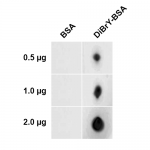Protein Oxidation
What is protein oxidation?
In chemistry, oxidation is a loss of electrons which corresponds to an increase in oxidation state. In biological environments, this is often manifested as an increase in the number of bonds to oxygen. Proteins are oxidized as a response to oxidative stress, which is defined as an imbalance of reactive oxygen species (ROS) and antioxidant defenses.
Protein Oxidation Mechanism
ROS such as hydrogen peroxide (H2O2), superoxide, and hydroxyl radicals can react with both the backbone and the side chains of proteins, leading to backbone cleavage and side-chain modifications, respectively. Tyrosine residues in proteins are susceptible to oxidation by free radicals, producing stable biomarkers such as dityrosine, dibromotyrosine, and nitrotyrosine.
Biomarkers of protein oxidation
Dityrosine
Two tyrosyl radicals can react to produce dityrosine cross-links between oxidized proteins.
Dibromotyrosine
Neutrophil myeloperoxidase (MPO) and eosinophil peroxidase (EPO), enzymes expressed in granulocytes, catalyze the formation of hypobromous acid (HOBr) from hydrogen peroxide (H2O2) and bromide ion (Br-). HOBr reacts with tyrosine residues in proteins to produce 3, 5-dibromotyrosine.
Nitrotyrosine
Oxidative stress produces reactive nitrogen species (such as nitric oxide) that react with tyrosine residues to form nitrotyrosine.
Protein oxidation research requires a great diversity of life science products. StressMarq is dedicated to developing cutting edge research products to aid in the study of protein oxidation, including antibodies, proteins, and ELISA kits.
View all Protein Oxidation Products
